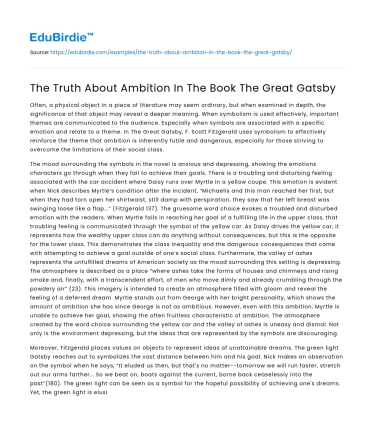Often, a physical object in a piece of literature may seem ordinary, but when examined in depth, the significance of that object may reveal a deeper meaning. When symbolism is used effectively, important themes are communicated to the audience. Especially when symbols are associated with a specific emotion and relate to a theme. In The Great Gatsby, F. Scott Fitzgerald uses symbolism to effectively reinforce the theme that ambition is inherently futile and dangerous, especially for those striving to overcome the limitations of their social class.
The mood surrounding the symbols in the novel is anxious and depressing, showing the emotions characters go through when they fail to achieve their goals. There is a troubling and disturbing feeling associated with the car accident where Daisy runs over Myrtle in a yellow coupe. This emotion is evident when Nick describes Myrtle’s condition after the incident, “Michaelis and this man reached her first, but when they had torn open her shirtwaist, still damp with perspiration, they saw that her left breast was swinging loose like a flap...” (Fitzgerald 137). The gruesome word choice evokes a troubled and disturbed emotion with the readers. When Myrtle fails in reaching her goal of a fulfilling life in the upper class, that troubling feeling is communicated through the symbol of the yellow car. As Daisy drives the yellow car, it represents how the wealthy upper class can do anything without consequences, but this is the opposite for the lower class. This demonstrates the class inequality and the dangerous consequences that come with attempting to achieve a goal outside of one’s social class. Furthermore, the valley of ashes represents the unfulfilled dreams of American society as the mood surrounding this setting is depressing. The atmosphere is described as a place “where ashes take the forms of houses and chimneys and rising smoke and, finally, with a transcendent effort, of men who move dimly and already crumbling through the powdery air” (23). This imagery is intended to create an atmosphere filled with gloom and reveal the feeling of a deferred dream. Myrtle stands out from George with her bright personality, which shows the amount of ambition she has since George is not as ambitious. However, even with this ambition, Myrtle is unable to achieve her goal, showing the often fruitless characteristic of ambition. The atmosphere created by the word choice surrounding the yellow car and the valley of ashes is uneasy and dismal. Not only is the environment depressing, but the ideas that are represented by the symbols are discouraging.
Save your time!
We can take care of your essay
- Proper editing and formatting
- Free revision, title page, and bibliography
- Flexible prices and money-back guarantee
Moreover, Fitzgerald places values on objects to represent ideas of unattainable dreams. The green light Gatsby reaches out to symbolizes the vast distance between him and his goal. Nick makes an observation on the symbol when he says, “It eluded us then, but that's no matter--tomorrow we will run faster, stretch out our arms farther... So we beat on, boats against the current, borne back ceaselessly into the past”(180). The green light can be seen as a symbol for the hopeful possibility of achieving one's dreams. Yet, the green light is elusive as it can not be reached, regardless of how much work is put into chasing it. Gatsby’s green light is Daisy and the general idea of being in the elite upper class. Even though Gatsby puts great effort into chasing the green light, it is useless. The differentiation between the two types of wealth, new money and old money, is too vast to be overcome because of how society has established opinions on each type. In addition, the clock symbolizes how it is impossible to control some things, even future objectives. When Gatsby reunites with Daisy, an unexpected situation arises when '...The clock took this moment to tilt dangerously at the pressure of his head, whereupon he turned and caught it with trembling fingers...” (86). Gatsby catches the clock unsteadily, which signifies how Gatsby is trying to manipulate time to his own benefit but has a hard time doing so. It is impossible to go back in time, therefore showing the unattainability of Gatsby’s dream. Even though Gatsby tries carefully to overcome obstacles to reach Daisy, time is an obstacle he can not overcome. Ambition does not change the fact that some things are not in Gatsby’s control. The idea of the unreachable end is seen through the symbols of the green light and the clock. These items show that ambition is actually futile since it will not change the factors that contribute to an unattainable dream.
In The Great Gatsby, symbolism is used to reinforce the theme that ambition is essentially useless and precarious, especially for those trying to overcome the constraints of the hierarchy of society. Fitzgerald does this effectively by creating an anxious mood surrounding certain symbols and placing significance on the idea of an unreachable dream. The recipe for success is not solely ambition as there are other necessary components such as social class. There are factors that are uncontrollable, that can affect the success of a dream. Ambition alone will not be able to surmount these barriers.






 Stuck on your essay?
Stuck on your essay?

